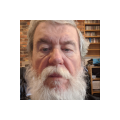1) "At the heart of the new Qosqo was the plaza of Awkaypata, 625 feet by 550 feet, carpeted almost in its entirety with white sand carried in from the Pacific and raked daily by the city's army of workers. Monumental villas and temples surrounded the space on three sides, their walls made from immense blocks of stone so precisely cut and fit that Pizarro's younger cousin Pedro, who accompanied the conqueror as a page, reported 'that the point of a pin could not have been inserted in one of the joints.' Across their facades ran enormous plates of polished gold. When the alpine sun filled Awkaypata, with its boldly delineated horizontal plain of white sand and sloping sheets of gold, the space became an amphitheater for the exaltation of light."
2) "Nobody knows how many died during the pandemics of the 1770s and 1780s, but even if one had a number it wouldn't begin to tally the impact. Disease turned whole societies to ash. Six Cree groups in western Canada disappeared after 1781; the Blackfoot nation, blasted by smallpox, sent peace emissaries to Shoshone bands, only to find that all had vanished. 'The country to the south was empty and silent,' Calloway wrote. So broken were the Omaha by disease that according to tradition they launched a deliberately suicidal attack against their enemies. Those who did not die quit their villages and became homeless wanderers.
Cultures are like books, the anthropologist Claude Lévi-Strauss once remarked, each a volume in the great library of humankind. In the sixteenth century, more books were burned than ever before or since. How many Homers vanished? How many Hesiods? What great works of painting, sculpture, architecture, and music vanished or never were created? Languages, prayers, dreams, habits, and hopes all gone. And not just once, but over and over again. In our antibiotic era, how can we imagine what it means to have entire ways of life hiss away like steam? How can one assay the total impact of the unprecedented calamity that gave rise to the world we live in? It seems important to try."
3) "Because we human beings are transitory, our lives as ephemeral as dreams, the tlamatinime suggested that immutable truth is by its nature beyond human experience. On the ever-changing earth, wrote León-Portilla, the Mexican historian, 'nothing is 'true' in the Nahuatl sense of the word.' Time and again, the tlamatinime wrestled with this dilemma. How can beings of the moment grasp the perduring? It would be like asking a stone to understand mortality.
According to León-Portilla, one exit from this philosophical blind alley was seen by the fifteenth-century poet Ayocuan Cuetzpaltzin, who described it metaphorically, as poets will, by invoking the coyolli bird, known for its bell-like song:
'He goes his way singing, offering flowers.
And his words rain down
Like jade and quetzal plumes.
Is this what pleases the Giver of Life?
Is that the only truth on earth?'
Ayocuan's remarks cannot be fully understood out of the Nahuatl context, León-Portilla argued. 'Flowers and song' was a standard double epithet for poetry, the highest art; 'jade and quetzal feathers' was a synecdoche for great value, in the way that Europeans might refer to 'gold and silver.' The song of the bird, spontaneously produced, stands for aesthetic inspiration. Ayocuan was suggesting, León-Portilla said, that there is a time when humankind can touch the enduring truths that underlie our fleeting lives. That time is at the moment of artistic creation."
4) "Even Henige, of Numbers from Nowhere, is no Low Counter. In Numbers from Nowhere, he argues that 'perhaps 40 million throughout the Western Hemisphere' is a 'not unreasonable' figure, putting him at the low end of the High Counters, but a High Counter nonetheless. Indeed, it is the same figure provided by Las Casas, patron saint of High Counters, foremost among the old Spanish sources whose estimates Henige spends many pages discounting.
To Fenn, the smallpox historian, the squabble over the number of deaths and the degree of blame obscures something more important. In the long run, Fenn says, the consequential finding of the new scholarship is not that many people died but that many people lived. The Americas were filled with an enthusiastically diverse assortment of peoples who had knocked about the continents for millennia. 'We are talking about enormous numbers of people,' she told me. 'You have to wonder, Who were all these people? And what were they doing?'"
5) "A visitor to the Northwest twenty thousand years ago might have seen such a craft bobbing over the waves like a long, floating balloon, ten or twenty men lining its sides, chasing minke whales with stone-tipped spears.
All of this is speculative, to say the least, and may well be wrong. Next year geologists may decide the ice-free corridor was passable, after all. Or more hunting sites could turn up. What seems unlikely to be undone is the awareness that Native Americans may have been in the Americas for twenty thousand or even thirty thousand years. Given that the Ice Age made Europe north of the Loire Valley uninhabitable until some eighteen thousand years ago, the Western Hemisphere should perhaps no longer be described as the 'New World.' Britain, home of my ancestor Billington, was empty until about 12,500 B.C., because it was still covered by glaciers. If Monte Verde is correct, as most believe, people were thriving from Alaska to Chile while much of northern Europe was still empty of mankind and its works."
6) "Indians as poster children for eco-catastrophe, Indians as green role models: the two images contradict each other less than they seem. Both are variants of Holmberg's Mistake, the idea that Indians were suspended in time, touching nothing and untouched themselves, like ghostly presences on the landscape. The first two sections of this book were devoted to two different ways that researchers have recently repudiated this perspective. I showed that they have raised their estimates of indigenous populations in 1492, and their reasons for it; and then why most researchers now believe that Indian societies have been here longer than had been imagined, and grew more complex and technologically accomplished than previously thought. In this section I treat another facet of Holmberg's Mistake: the idea that native cultures did not or could not control their environment. The view that Indians left no footprint on the land is an obvious example. That they marched heedlessly to tragedy is a subtler one. Both depict indigenous people as passively accepting whatever is meted out to them, whether it is the fruits of undisturbed ecosystems or the punishment for altering them."
7) "My ancestor Billington's great-grandchildren may not have realized it, but the impenetrable sweep of dark forest admired by Thoreau was something that Billington never saw. Later, of course, Europeans stripped New England almost bare of trees.
When the newcomers moved west, they were preceded by a wave of disease and then a wave of ecological disturbance. The former crested with fearsome rapidity; the latter sometimes took more than a century to tamp down, and it was followed by many aftershocks. 'The virgin forest was not encountered in the sixteenth and seventeenth centuries,' wrote historian Stephen Pyne, 'it was invented in the late eighteenth and early nineteenth centuries.' Far from destroying pristine wilderness, that is, Europeans bloodily created it.
By 1800 the hemisphere was thick with artificial wilderness. If 'forest primeval' means woodland unsullied by the human presence, Denevan has written, there was much more of it in the nineteenth century than in the seventeenth.
The product of demographic calamity, the newly created wilderness was indeed beautiful. But it was built on Indian graves and every bit as much a ruin as the temples of the Maya."
8) "With two calendars, every day thus had two names, a sacred tzolk'in name and a civil haab name. Usually the Maya referred to them by both at once: 1 Ix 0 Xul. The two different calendars, each perfectly regular (but one more regular than the other), marched in lockstep, forming what is now called the Calendar Round. After one 1 Ix 0 Xul, there would not be another 1 Ix 0 Xul for 18,980 days, about fifty-two years.
By describing dates with both calendars Mesoamerican societies were able to give every day in this fifty-two-year period a unique name. But they couldn't distinguish one fifty-two-year period from its predecessors and successors—as if the Christian calendar couldn't distinguish 1810, 1910, and 2010. To avoid confusion and acknowledge time's linear dimension, Mesoamerican societies invented the Long Count, which counts off the days from a starting point that is believed to have been in mid-August, 3114 B.C. Long Count dates consisted of the number of days, 20-day 'months,' 360-day 'years,' 7,200-day 'decades,' and 144,000-day 'centuries' since the beginning. Archaeologists generally render these as a set of five numbers separated by dots. When Columbus landed, on Tuesday, October 11, 1492, the Maya would have marked the day as 11.13.12.4.3, with the 'centuries' first and the days last. In the tzolk'in and haab, the day was 2 Akbal 6 Zotz.
Although extant Long Count dates have only five positions for numbers, the Maya knew that eventually that time would pass and they would have to add more positions. Indeed, their priestly mathematicians had calculated nineteen further positions, culminating in what is now called the alautun, a period of 23,040,000,000 days, which is about 63 million years. Probably the longest named interval of time in any calendar, the alautun is a testament to the grandiosity of Mesoamerican calendries. Just as the tzolk'in is one of the most impeccably circular time cycles ever invented, the Long Count is among the most purely linear, an arrow pointing straight ahead for millions of years into the future."


